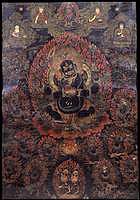
|
Mahakala Chakshipa (painting no. 517)
|

View Larger Image |
||||||||||||||
|
Caturbhuja Vajra Mahakala (Tibetan: dor je nag po chen po, chag shi pa, English: The Great Vajra Black One with Four Hands), the protector for the Cakrasamvara cycle of Tantras. With one face and four hands, he is extremely wrathful in appearance. The first pair of hands hold a coconut fruit and a skullcup filled with blood. The second right hand holds upraised a sword blazing with wisdom fire and in the left a katvanga staff topped with a trident. Orange hair flows upward as he stares with glaring red eyes and a wide gaping mouth. Adorned with the bone, gold and jewel ornaments of a wrathful deity he wears a necklace of fifty freshly severed heads and a long green snake as a Brahmin cord. Seated in the relaxed 'vira' (hero) posture on a sun disc and red lotus seat he is completely surrounded by the flames of pristine awareness. At the top center is Sahaja Heruka Cakrasamvara, blue, with one face and two hands holding a vajra and bell embracing the consort red Vajravarahi. They stand on a red lotus above a black garuda clutching a snake with the hands and beak. To the left is the Great Lama of Shang, seated, wearing monastic robes and a religious hat in the style of Gampopa. Below that is a yogi wearing a red meditation belt and holding a vajra and bell. To the right of Cakrasamvara sits the great Lord Barawa, wearing monastic robes, a pandita hat and holding a vajra and bell. Below and to the right is Lord Tsewa'i Lama Chokyi Gyatso wearing monastic robes, a pandita hat and performing the blessing mudra with the right hand and holding a long-life vase in the left. To the right of Mahakala is wrathful Candika, red-black in colour, with one face and four hands holding a sword and trident in the right and a bow and arrow and the head of an enemy in the left. She rides on a mule surrounded by flames. On the left side is another wrathful goddess with one face and four hands holding a sword and skullcup in the left and a kila (peg) and the head of an enemy in the left. She also rides on a mule surrounded by the flames of wisdom. Below and to the right is Simhamukha (The Lion Faced One) holding a sword in the right hand and a heart in the left. To the left side is Kakasyamukha (The Raven Faced One) holding a curved knife and skullcup. Both are black in colour and stand on corpse seats. At the bottom center is Citipati (Lords of the Funeral Pyre) appearing as two dancing skeletons each holding a bone stick and skullcup. Surrounding them are two rows of four figures. The upper four have heads of birds, beginning on the left side is the Owl Faced One, Vulture, Garuda and Raven. The lower four are The Dog Faced One, Pig, Tiger and Jackal. All are female, black in colour, with one face and two hands holding a curved knife and skullcup. Standing upon a corpse seat and sun disc and completely surrounded by the flames of wisdom they are extremely wrathful. All the deities save for Citipati belong to the immediate retinue of Caturbhuja Mahakala. From a general perspective there are many lineages of Caturbhuja within the Nyingma and Sarma traditions. In the Sarma all lineages derive from the great pandita Abhayakaragupta. As the protector for the Cakrasamvara cycle of Tantras this form of Mahakala is very important to the various Kagyu Schools. The painting belongs specifically to the Drukpa, and along with the Drikungpa, they have both steadfastly maintained the lineage and practice as a special precept. Lineage: Vajradhara, Bodhisattva Mati, Nagarjuna, Aryadeva, Acaryavira, Du Shap Greater and Younger, Vajrasana the Greater, Abhayakaragupta, Tsami Sangye Shap, Gva Lotsawa Namgyal Dorje, Khampa Aseng, Phagmodrupa, Drikung Jikten Gompo, etc. The names of the lamas along the top, Mahakala, and Citipati at the bottom are all inscribed in fine gold lettering beneath each figure. The method of painting is called 'nag thang,' (black scroll) gold outline on a black background. J.Watt 6-98
|
|||||||||||||||
Photographed Image Copyright © 1998 Shelley & Donald Rubin Foundation
|
|
| |
Next Image |